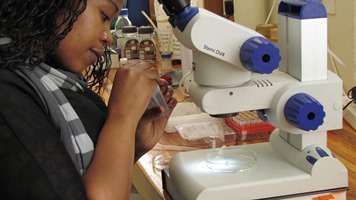Postdoctoral Research Fellow, Stellenbosch University
There’s an invading army attacking our precious fynbos; you may not know about it, but fortunately, Dr Natasha Mothapo is on their tracks.
The army is the Argentine ant, an invasive species from South America that has spread across the world, from Easter Island to Europe to Hawaii. The species has been introduced at two different times into South Africa, and it’s creating havoc in the biodiversity hotspot that’s home to our fynbos.
“They’re so fascinating,” says Mothapo. She’s done both her master’s and her doctorate on these ants.
Which comes as no surprise to her family. Born and brought up in Alexandra, Johannesburg, Mothapo always loved animals.
“I had a dog and pet pigeons, and when we were at our home in Limpopo, I was always grabbing lizards and stuff like that. I think the attraction to science really began in grade five when we went on a field trip to the Kruger National Park. My folks were not surprised that I ended up where I am.”
Stellenbosch University came calling at her school to recruit students and the institution leapt at the chance of teaching someone with such an affinity for biology. “I’ve been here since 2001 – it has grown on me.”
Mothapo’s master’s supervisor suggested she take a look at these invasive ants. Native ants eat white, oily appendages called elaiosomes that are attached to fynbos seeds – they carry the seeds underground and leave them there, protected from fire and predators. Argentine ants also eat the elaiosomes, but they leave the seeds on the surface, exposed. So figuring out a way of minimising the invasion is a priority.
She flew to Cairns, Australia in mid-July to present at the International Union for the Study of Social Insects Conference. She’ll return to do more work on her ants, but in the future, she thinks she may find herself either teaching or working on policies to manage invasive species.
— Mandi Smallhorne
LinkedIn: Natasha Palesa Mothapo


